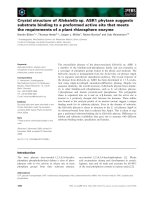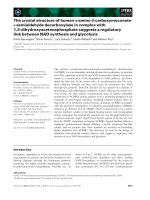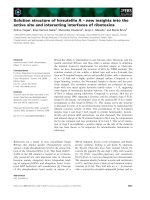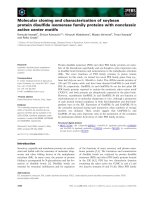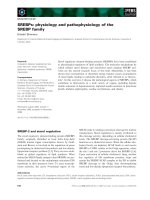Tài liệu Báo cáo khoa học: "The Structure and Process of Talking About Doing" pdf
Bạn đang xem bản rút gọn của tài liệu. Xem và tải ngay bản đầy đủ của tài liệu tại đây (230.09 KB, 4 trang )
The
Structure and Process
of
Talking About Doing
James A. Levln and Edwin L. Hutchins
Center for Human Information Processing
University of Callfornia, San Diego
People talk •bout what they do, often •t the same
tame a• they are doing. This reporting has •n
important function in coordinating
aotlon
between
people working together on real eve~/day problems. Zt
is also •n
important acts'ca o£
data
for
social
scientists sttu~ylng
people's
behavior. Xn this
paper,
we report on some •tudle• we are doing on report
dialogues. We describe two kinds of phenomena we have
identified, outline a preliminary process model that
int•grat•• the report generation with the processes
that are generating the actions being reported upon,
and specify a systematic methodology For extracting
relevant evidence bearing
on
these
phenomena
t~om text
trenscrlpts of talk about doing to use in evaluating
the model.
~OZW~W
Reports of problm solving actions are often used a•
evident• about the und•rlying cognitive processes
involved in generating a problem solution, as "problem
solving protocols" (Howell & Simon, 1972). However,
these reports ere obviously a kind of language
interaction in their own right, in which the subject i•
reportlns on hls/hor own actions to the experimenter.
We have analyzed problem solving protocols of people
solving
a puzzle called
"Hlsslonaries and Cannibals"
and have found that in their report•, people adopt •
• point or view" with respect to the problan, through •
con•latent use of spatial detxts, For example, when a
subject lays:
" , X can't send another cannibal across with
another alssioflary or he will he outnumbered when he
gets to the other side , "
the deixis In her report places her as speaker off the
• from" side of the considered action, This is
indicated both by the choice of the verb "send" and by
the description of "the other side". ?he same suhjeot
indicated the "to n slde as her point
or
view
in
another
part or her protocol:
", 'cause you've gotta have one person to hri~
back the boat " 4
Here, both the verb "bring" and the adverb "back"
indicate "point
ot
view".
Although people almost always unmmbiguoualy
specify • "point of view" within the problem they are
solving in their reports, they also deny awareness of
takAn| such • point cF view, However, this point or
view is important to the underlying problem solving
procesmas. The strongest evidence for this comes ~om
the hi|h correlation ~etween Point or view and errors
in problem solving actions. Subjects in the
~tlsslonarles and Cannibals task
can
make
errors
by
Cabin| actions that violate the constraints or the
task. Host of these errors occur on the side away frm
their current "point st view", even theuah their point
of view changes From one physical side to the other
during
the course or solving the punle, mre
interesting is that most of the "undetected" errors
emcur on the side •way from their point or view. Some
errors arm spontaneously detected by the subject
~mmediately otter askant the action
that
leads to •
violation! others ere "undetected". After the
experimenter interrupts topolnt out these undetected
errors, the subjects
often
switch point of
view
so that
the violation condition is now on the same side a• the
subjects'
point of
view.
We see the point of
view indicated by
•patlal
delxls In the
report
of problem solving as reflec~ir~
an underlying allocation of effort (or attention). Pew
errors occur with problem elements that •re given
processing effort, while constraints that •re given
little attention are more often violated.
%n this way, these reports are reflecting changes Zn
the organization of the
problem
element• that occur
over the course of reaching a solution. We have also
identified other ways in which report• embody the use
of different conceptual organizations of the problem,
including org•nlzatlons that vary from abstract
to
concrete and from perception oriented to action
oriented.
JUSTZrZCATZON~~
There •re multi-utterance structures that occur
regularly in problem solving talk that we call
• justltAoatlon argument structures." These structures
have the form of:
(did ) (do ) (since )
(could)+(not do)+(aotion).(bsc•use)->(Justitloatlon
(will) argument)
(Alternatively, these two segments san he reversed in
order, by using connectiv•s like "theretora" or "so".)
For example, these kinds of dialogue units occur in
many ot the protocols studied by Newall & Simon (1972):
"hen letter has one and only one numerical value
,e.
'([: One numerical value.) There are ten different
letters and each of them has one numerloal value.
Therefore,
Z
san, iooklng at the Wo D's each D is
5; therefore, T is zero." (Hewell& 8Amen,
1972:230-231)
Zn studying our problem solving protocols tram the
~tseionarles and Cannibals puzzle, we have Identltied
several kinds of argument structures, depending on what
kinds of problem solving approach ••oh subject took to
the problem at each point An time. For example, one
common justification argument structure is the
• elimination cf alternative•" struntur•: All av•Llabte
aotlons A. From this state except A i can be ruled cut.
Therefore-do actlon A i, Here is an-example of this
Mind of argument struSture:
• %f
Z put
a cannibal on, then he gee• hack and
the guys
on
the other side
of
the river, the
misslcnary, is outnumbered and he will be eaten.
Zt % put on this is all my oonbinatioa• and
permutation• 2t Z put ton
mission•flea
on, Z
wan two cannibal• on the boat and send them back,
then At As Just ridlculou• •t the other end
so what %'11 have to do As one ot eenh."
Another argument rcrm Is one we
call
"prapatio
ark,sent".
(We
have
borrowed many or our naaes for
79
arlmemt etruoturoe Prom a rhotor%o boo~ (Perelmsn &
O%hreohta-Tyteea, I~5g).) Altho~h 5hie book Ln I
"noru51vo" aooount oF erlmentatLon, we PLnd £t
valuable ae a
~Ado to our
atSempt
~o
l~VO i
deaerlptlve aooount or naturaAly eeeurr~ng %nFomal
"or|lentat¢en" eoe~rr%n| An our eub~eoto' reports oF
theAr problem eolv~ng,) ?he prqitAe er|~mente %at
MAng
lOt%on A would Lead to relult R (Imonll ocher
~hlnSe). ROltA~t fl Le undoeLrlble. Therefore don't do
aotlon A.
enemple Prom our pretooole lot
0,,, Hoth ~LeeAonar£ea
are
IO£ng 5o
have
to
eema
boom beoauee. 'oauea
%T 5hey
don't eemo booM,
veil, one ~e~d pt left and eaten. So beth
mAeeloaar~oe oeme book
"
One XntoreatAng ~Ant about 5h~a ~rt~e~ar example %8
5hat ~t %e embedded wlthAn an "el~mlnatAon of
alternat£voo" arll~Nnt etruoture. The5 %a, 5hAm
"prqitAo arluaent" 18 used 50 el~aAnaSe one oF 5he
alternatives, leav£ng
only one 50
5eke.
A third kAad oF arguaen5 atruoSure we have
ideaS%Fled 18 railed "ende-moane"t %P erase S oooure,
then there ~e an aotAen A to set 5o seal O. ?herefore
eesamLAah orate
S
am a
eubleal.
for exemplar
" 3e Lr ever % oould |e5 ~hoee ever 5here, %
Obviously, 5ham ar|wJent Fern %o similar 50 5he olaJe%o
"means-ends oflalye£o" proposed ae ~rt of many serpent
5hear%re
oF problem aolv%ng.
The
arlmmon5 Peru we
hive identified bOOer v~en oIPCIAn k~ndo ot underlying
oolnit%ve prooeeoing Is IoLng on, end thAI ~,~nd oF
protooo% 5ext h~e been
Ulld ll
evLdonoe for 5his
~ndorXying prooeaming. Some people have lllUmOd t~H|5
5hal ~nd of languap Anteraotion oorreepondo to a
euboea of 5he underly£n8 prooeseee (Nevoll i SAmon,
~973). Other people have questioned whether there %e
any oorreapondenoe between vha5 people do Imd what 5hey
say (NLsbett & ~llmon, 1977). Our position le 5hat
5here
%e a
Fairly rieh
~nSereoSien between motion and
report o~ aot~cn, mioh we will doeorihe %n our report
OF our prel~m~ary proaese node/, of doing and
rlportinl. (This poeitinn %8 oin£1or 5o one outlined
reeently
hy Rrloeaon ~ SAmoa (1979).)
A ~a~csaa ~ O~ nn~aq AH~ ~L~
He have been oonatruotlng a proeeee model oF
problem
solving ~thin
an aot~vatlon preeemo
~unevork
(Seven, 1976; 1970). ~15hAn 5hie FremevorK, nultAple
proneness are 8%nultaneoue~y aot/.ve, end 5he 5he
%nteraoC~ona between
5he aatlve prooeasea %o epeo~tAed
by 5heir re~eeonCotiona %n a netvorM otruotur~ %one
term memory. Emoh prooeoe %e so+lYe a oct+sAn aununS,
with
a oor~aAn
smotmt oF
nalIAenoln,
and
~he more
oaIAent a preoeaa As, 5he lar|er %5e %npae5 on oSher
presences (and therefore on the overall prooeaoLng).
There ere prooeleee tha~ ere oloeely relltld ~O
the
~r~romnoe oF
5he
problem tooK, lad o~here tt~c
are oZoeely related to the report of the task aoClona.
~n the psr~lo,,~ar problem demean of the H~aeionsr£ee
and CannLbae8 pusxle,
5he
~aek POliCed ao~Lonl and
obJeo~e
are
defined as oonoopco
An the
long 5emnemory
thaC beoome aoClve durlng the ?rob/.em solving. The
oonsCrl£n58 of 5he problem ape represented Ln 5he name
way, and leC
aoSivoSed 5o varying
delrwee
during
5he
problem so/.v~ng. ~-roro ooour when the oonacre/.n~e are
%neutrlolenC%y 8aAAenC to prevent an notion wh£oh landl
~o
a
v~o/.oS/.on
oF 5ha& oonecraAnC.
Report related proeeaeoe impost 5he tao~ behavior
by mod%Fy£n| 5he distribution o~ lelAenoe 5o 5he 5ask
related proneness, "Point oP v~ew" of 5he problem
lOlver hll L51 Ampeo~ on the presses%n| by add%n|
ealAenea 5o 5hose ooSAvo eonoopte Jesse%sand ~th
looatLon where the problem ~lver ham oonooptuaLly
looated hAmthereelF, ~uet%P%eat%on arjUmlmt etruoturea
l~l~lirly Ampao5 5he d%etr%butAon of emlAenoo by
~noreao%ng 5he sa%%enoe st or 5.see LnFerenee prooealol
defined to be 8llJOO£lted wAth the arlumen5 structures.
~n 5h~e ~sy, ~aKua|e san lad 5he problem solving, by
addle| 50 5he roeouraoe of 5he 5nAked soon5 proooeaeo,
%t ann sees h~nder %t %t looks the problem solver into
a psrtAoular orlenLutLon oF the problem 5hit %On't
f~U~tFul, rap example, to 5he extent 5h~t llmlus|e use
Foouaeea eaIAenoo sway From oonetrlAntl t~5 ire beL~J
v%olated oaul~ng effete, end elpoOLlALy LF 5hAl ooourl
to euoh In extent 5ha5 5hone
IPrOrl Ire
undeSeoSed,
thin the FoOUSlL~ll eFFeot oF languilo elm be l bert%It
5o solving the problem.
80 tar, we have deoor%ba none phenomena ve Mve
observed In our solleetion or problem solvlM reports,
and also m prel~,,%nary proooea model st problem eo%v~nJ
aat~on and report, How san we use sup data 5o evalu|te
our model?
?here are Ray Levels oF evaluative tent:Leg that
we could use. At one extreme, 5heor4eo sin be strongly
evaluated by doriv:Ln| prodAot~ono Prom 5hem of' epoolF:Lo
da5a, vhAoh Le 5hen eo%leo5ed. I~peo~ally when 5he
prod:Late4 da5a are unexpeotedt th:Lo prov:Ldee a r~Joroua
5net OF s theory.
At another extreme ~0 a "ouFtAo~enoy teacn (Howell &
81mona 19TO), A model oF an orpn£mD porform.'Lnl name
tael¢ pasha 5he euf'Fio%enoy 5on5 %F Lt aloe san perForu
ohm name tank. Than %e the evaluatAon 5eat oemmon%y
used today For strafe.sial AntelIA|enee models.
A
more r~l;orous 5eat %e 5n Cry to
F~.5 a
mode/. 50 • emma
OF data.
?hAs ~e
the evaluate.on 5eahn~quo moot often
UJld today An evaluat~,ng ooln~tlve poyoholo|y 5hoor~ea.
A Fourth Ceo~lqua %e to %denSity a set of "or£cioxl"
phenomena In 5he data spinet MtAoh to evaluate a mode%
OF the5 data,
AI
~lluotratod ~.n the liJ~ below, th:Li
£s a more powerful evaluation teoiutique 5hit e~nple
euFt~o£enoy, but lees povorF~ 5hsn 5he other two
5eohnLquee. Vo Fee). 5hat It 5has point In 5he scats OF
the opt, 5hie te 5he appropriate evoluat~on 500hnique
to use 5o evalunto our presell modll ~n IAIh5 of our
dltl.
1, -qLa~in{ilqnv; DOle the nodo~, I~obel~y porFoM0 ~ke
the behavior being mdollld?
2. ~ ohann~: Dose 5he model exhib15
behavior that oorreeponda to observed seleo~ed
• oritioaA phenomena n An the dal~a of interest?
3. Close ~ ~ ~S ~n the model exhih:L?, beJ'dltvior
that oorreeponds oAoeely to the nneo of do5o el'
interest?
~, Pridln~Lon ~ uni~nia~id dlEt~| Clfl the nodv4
exnib/.5 unexpeocod behavior the5 then son be
observed?
%n
order 50 emtreo5 5he phenomena we hove
Adent~F%ed An our data For urns Ln evaluating our model,
we have boon develop:Leg sod/no 5eol~niquee 5hat are used
by trained human oodoPe. Theme oodere de~eo5 and
annotate the oeourrenoe OF 5hems phenomena Ln
~,rammor:Lp~e OF prob/.en solvlng &oak. For exmmp/.e, we
have been able to treAn ooder8 I:o reZAsbly de~erm£ne a
80
"point of view" for a problem solver at each point in
the problem solving from a record of the problem
solving report and a record of moves made. Then, we
use this extracted trace to evaluate our model of the
role of point of view in problem solving.
SUMMARY
We have reported here a three
pronged approach to
the study of problem solving action and report: I) the
collected of data on problem solving and talk about
problem solving, 2) development of a process model of
these behaviors, and 3) use of coding techniques to
extract traces of "critical phenomena" from the
transcripts for evaluating the model. So far, we have
focussed our efforts on two types of problem solving
phenomena: the changes in the problem solver's
organization of the problem ("point of view"), and
systematic multl-utterance structures used to express
the forms of inference used to solve the problem
("Justificatlon argument structures").
Ericsson, K.A., & Simon, H.A. Thlnking-aloud protocols
as data: Effects of verbalization. Pittsburgh, PA:
Carnegle-Mellon University, C.I.P. Working Paper
#397, 1979.
Levin, J.A. Proteus: An actlvation framework for
cognitive process models. Marina de1
Rey,
CA:
Information Sciences Institute, ISI/WP-2, 1976.
Levin, J.A. Continuous processing with a discrete
memory representation. Paper presented at The LNR
Confluence, La Jolla, CA: Center for Human
In/ormation Processing, UCSD,
1978.
Newell,
A., & Simon, H.A.
Human oroblem solvln~.
Englewood Cliffs, NJ: Prentlce-Hall, 1972.
Nisbett, R.E., & Wilson, T.D. Telling more than we can
know: Verbal reports on mental processes.
Psychological Review.
1977,
84,
231-259.
Perelman, C., & Olbrechts-Tyteca, L. The new~:
A treatise on~r~. Notre Dame, IN:
University of Notre Dame Press, 1969.
81





